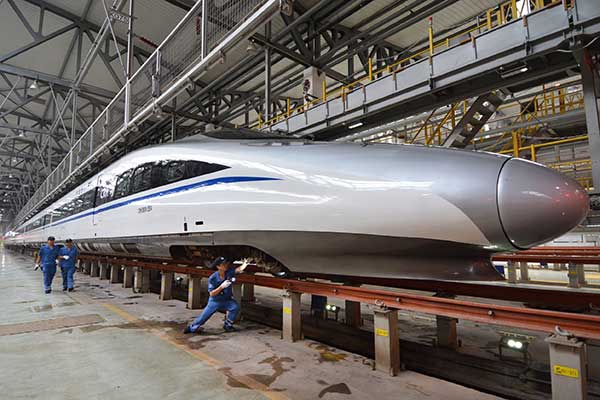
Workers check a high-speed train in Tianjin.[Photo/Xinhua]
China’s high-speed railway network is expected to span 18,000 kilometers by the end of this year, building a solid foundation for an industry that can generate new market growth points during the nation’s 13th Five-Year Plan period (2016-20).
Official data from China Railway Corp, the country’s railway service provider and planner, shows that China will add another 2,000 kilometers of high-speed railroad by the end of this year, the final year of the country’s 12th Five-Year Plan period (2011-15).
This is part of the government’s plan to put more than 8,000 kilometers of extra lines in both regular and fast-speed railway networks into operation.
The railway construction target was announced by Premier Li Keqiang in the Government Work Report earlier this year. The report also said that by the end of this year, all cities in China with a population of more than half a million will be connected by high-speed railways.
Rong Chaohe, professor at the school of economics and management in Beijing Jiaotong University, said China plans to build more high-speed railroads in the nation’s western region during the 13th Five-Year Plan, as well as export more high-end railway equipment products to overseas markets.
Wang Mengshu, an academic at the Chinese Academy of Engineering, said eager to make more breakthroughs in this fast-developing sector, China will continue to deploy more resources and manpower to further develop “smart trains”, which apply intelligent technology that will allow trains’ speed control, condition determination and fault detection operations to be performed digitally.
China has also set a target for carrying out research and making innovations in the permanent magnetic motor technology for the high-speed train power systems, as most of the existing units run on alternating current.
“Permanent magnetic motors will consume less energy and improve trains’ reliability, which is a trend in the research on high-speed trains,” said Wang.
The nation aims to form a comprehensive transport network by the end of this year, with four high-speed east-west arteries and four north-south arteries as the backbones. The national high-speed railway and the national expressway networks are both expected to take shape during this period.
Luo Renjian, a researcher at the Institute of Transport Research, under the National Development and Reform Commission, the nation’s top economic planner, said high-speed trains are always the preferred option for passengers in China. These trains overcome the disadvantages of coaches, which have a poor safety record in particular for overnight services, and they are more convenient than planes.
“High-speed railway lines are practical models that can offer bright prospects for the rail sector, especially for strategic investors,” said Luo. “Successful examples such as the high-speed rail routes including Beijing-Shanghai, Guangzhou-Shenzhen and Shanghai-Kunming have all showed that stable passenger demand can generate handsome financial returns from a long-term perspective.”
For instance, ticket sales on the Beijing-Shanghai route amounted to 30 billion yuan ($4.71 billion) in 2014, with a net profit of 1.2 billion yuan. The line carried more than 100 million passengers between the two cities, up 27 percent from a year earlier.
More importantly, Luo said high-speed lines can help the government balance disparities in economic development between the eastern and western regions, as well as showcase the reliability and sales potential of the industry to the global markets.
Railway investment has seen a steady increase during the nation’s 12th Five-Year Plan (2011-15), from 580 billion yuan in 2011 to 800 billion yuan in 2014, according to the Ministry of Transport.
China had more than 16,000 kilometers of high-speed rail at the end of 2014, up from 11,028 at the end of 2013, and 28 of the mainland’s 31 provinces, autonomous regions and municipalities now have access to bullet trains.
China introduced high-speed rail service in 2007 and its daily users have increased from 237,000 in 2007 to 2.49 million last year. The country now owns the world’s longest high-speed railway network.
CRC provided services to 1.94 billion passengers between January and September this year across the country, up 9.8 percent year-on-year.
